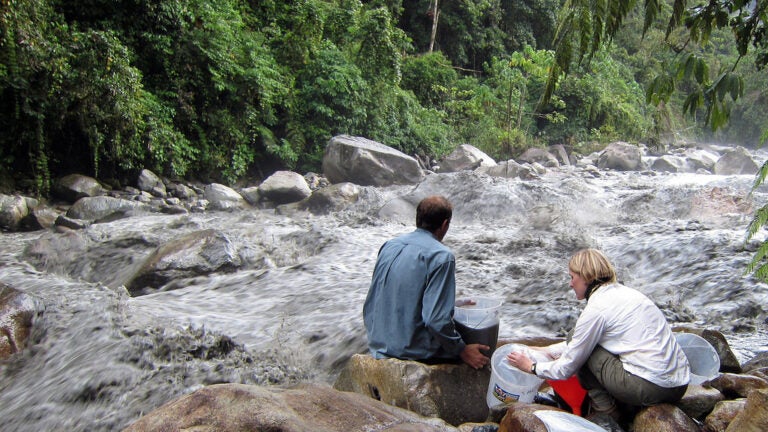
Climate Change in the Amazon
USC Dornsife scientists headed to Peru’s cloud forests to study the roles of forests and rivers in carbon cycling. Carbon dioxide, or CO2, is a key greenhouse gas and scientists are eager to understand how carbon dioxide, taken up by plants, is exported as organic carbon in rivers.
Plants soak up CO2, and when they die and decay, some of that CO2 returns to the atmosphere. But some of the carbon washes into rivers and drains to the ocean where, if it survives the journey, some fraction of it is locked away in sediment. Understanding how the Amazon River catchment — the world’s largest water-collection area — transports this carbon is important for understanding the overall impact of rivers on the transport of the world’s carbon.
Led by Josh West and Sarah Feakins of earth sciences, the researchers discovered that molecules in ocean-bound leaves recorded changes in conditions of the catchment along the way, critical data in understanding those changes. The findings of the research, which was funded by the National Science Foundation, were recently published in Geophysical Research Letters.
En Español:
El Cambio Climático en el Amazonas
Científicos de la Universidad del Sur de California viajaron a los bosques de niebla del Perú para estudiar el papel que desempeñan los bosques y los ríos en el ciclo del carbono. Visite a nuestro album digital de fotos para seguir la investigación.
El dióxido de carbono (CO2) es un gas que produce efecto invernadero y los científicos quieren entender cómo el dióxido de carbono que es absorbido por las plantas termina siendo exportado del ecosistema por los ríos en forma de materia orgánica.
Las plantas absorben CO2 de la atmósfera y lo incorporan en sus tejidos. Al morir, una parte de esta materia orgánica se descompone liberando de nuevo el CO2 a la atmósfera. Otra parte cae a los ríos y es transportada hacia el mar. Si resiste el viaje, la materia orgánica es enterrada en el fondo del mar junto con otros sedimentos. Este proceso representa una remoción de carbono de la atmósfera. La cuenca del Río Amazonas constituye el área de recolección de agua dulce más grande del mundo y estudiar cómo se transporta el carbono por ésta cuenca es importante para llegar a entender el impacto que pueden tener los ríos en el transporte de carbono a nivel global.
Acompañe al equipo de investigación mientras le siguen la pista al carbono, desde las cabeceras del Río Amazonas en los altos Andes hasta las selvas de la planicie Amazónica del Perú, en su trayectoria hacia el Océano Atlántico.
Los resultados de esta investigación, financiada por la Academia Nacional de las Ciencias de USA, han sido recientemente publicados en la revista científica Geophysical Research Letters.